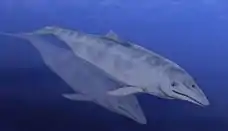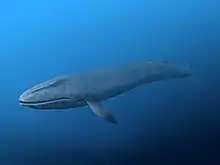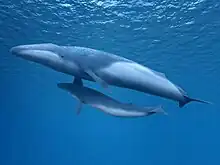Ashorocetus
Ashorocetus is a monotypic genus of an extinct primitive baleen whale of the family Aetiocetidae. It was named by Barnes et al. 1995, and contains one species, A. eguchii. Fossils of this whale are found from the Chattian Morawan formation, near Ashoro, of upper Oligocene (28.4 to 23.03 million years ago) Hokkaido, Japan (43.3°N 143.8°E, paleocoordinates 44.6°N 141.4°E).[1][2] Ashorocetus eguchii was described based on a partial skull and is named after the type locality and Kenichiro Eguchi of the Ashoro Museum of Paleontology.[3]
| Ashorocetus Temporal range: Oligocene, | |
|---|---|
| Scientific classification | |
| Domain: | Eukaryota |
| Kingdom: | Animalia |
| Phylum: | Chordata |
| Class: | Mammalia |
| Order: | Artiodactyla |
| Infraorder: | Cetacea |
| Family: | †Aetiocetidae |
| Genus: | †Ashorocetus Barnes et al. 1995 |
| Species | |
|
†A. eguchii (type) | |
Description
Barnes et al. 1995 described four new aetiocetid species, of whom Ashorocetus eguchii was the most primitive. It has a neatly telescoped skull and is closely related to Chonecetus, another primitive aetiocetid. Barnes et al. also described Morawanocetus yabukii, a more derived species with a foreshortened braincase, intermediate between Chonecetus and Aetiocetus; Aetiocetus tomitai, the most primitive Aetiocetus discovered; and Aetiocetus polydentatus, the most derived Aetiocetus with a highly telescoped cranium and both homodont and polydont dentition. Barnes et al. also proposed three subfamilies for Aetiocetidae (Chonecetinae, Morawanocetinae, and Aetiocetinae) to reflect this proposed evolution within the family.[4] The placement of A. polydentatus in Aetiocetus has, however, been questioned, as has the monophyly (and therefore the proposed subfamilies) of Aetiocetidae.[5]
Sister taxa
References
Notes
- "Ashorocetus". Fossilworks. Retrieved 17 December 2021.
- "Morawan (Kamirawan Sandstone Member) (Oligocene of Japan)". Fossilworks. Retrieved 17 December 2021.
- "Ashorocetus eguchii". Paleocritti. Retrieved 31 December 2013. (including an illustration of the holotype)
- Barnes et al. 1995, Abstract
- Deméré & Berta 2008, pp. 308–309
Sources
- Barnes, L. G.; Kimura, M.; Furusawa, H.; Sawamura, H. (1995). "Classification and distribution of Oligocene Aetiocetidae (Mammalia; Cetacea; Mysticeti) from western North America and Japan". The Island Arc. 3 (4): 392–431. doi:10.1111/j.1440-1738.1994.tb00122.x.
- "L. G. Barnes et al. 1995". Fossilworks.
- Deméré, T. A.; Berta, A. (2008). "Skull anatomy of the Oligocene toothed mysticete Aetioceus weltoni (Mammalia; Cetacea): implications for mysticete evolution and functional anatomy" (PDF). Zoological Journal of the Linnean Society. 154 (2): 308–352. doi:10.1111/j.1096-3642.2008.00414.x.
- "†Ashorocetus Barnes et al. 1995 (whale)". Fossilworks.
- Rose, Kenneth David; Archibald, J. David (2005). The Rise of Placental Mammals. JHU Press. p. 236. ISBN 0-8018-8022-X.



